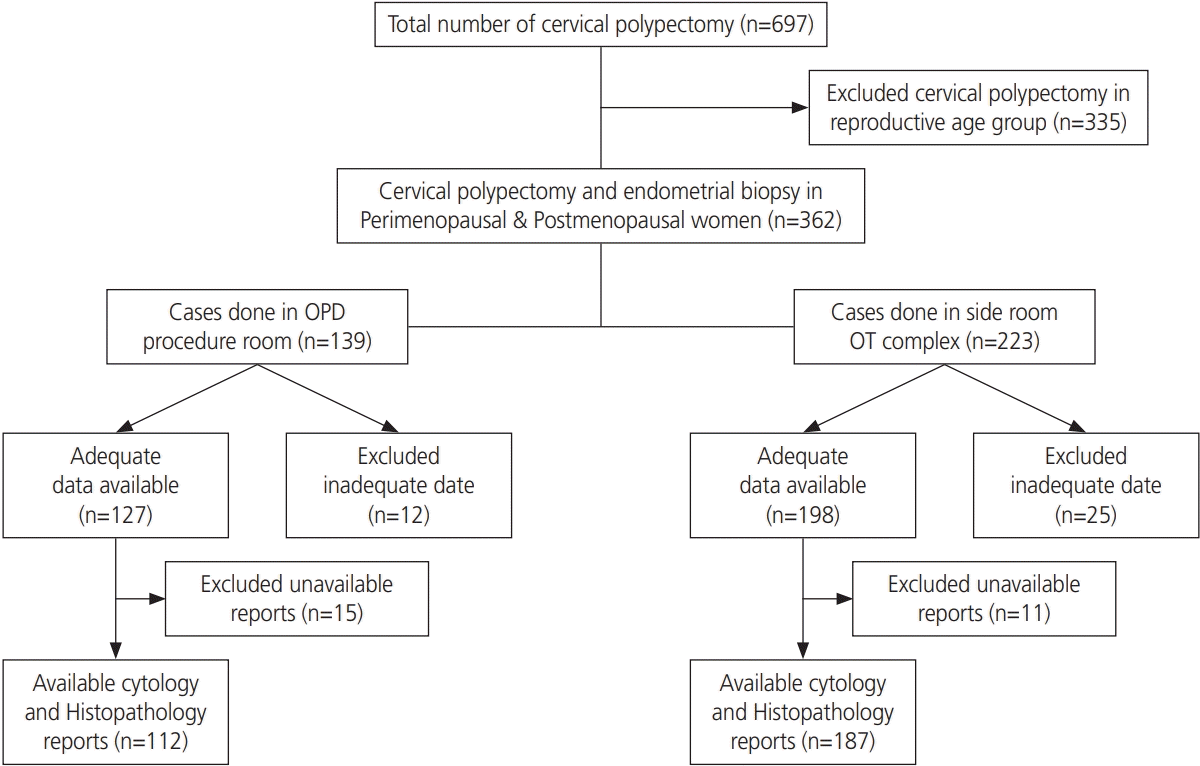1. Farrar HK Jr, Nedoss BR. Benign tumors of the uterine cervix. Am J Obstet Gynecol. 1961; 81:124–37.

2. Khachikyan I, Stratton P. Chapter 40: Benign disorders of the uterine cervix. In : DeCherney A, Nathan L, Goodwin TM, Laufer N, editors. Current diagnosis & treatment: obstetrics & gynecology. 11th ed. New York (NY): Lange (McGraw-Hill);2014. p. 657–59.
3. Cortan RS, Kumar V, Collins T. The female genital tract. Robbins pathologic basis of disease. 6th ed. Philadelphia (PA): Elsevier;1992. p. 1042–8.
4. Schnatz PF, Ricci S, O’Sullivan DM. Cervical polyps in postmenopausal women: is there a difference in risk? Menopause. 2009; 16:524–8.
5. Berzolla CE, Schnatz PF, O’Sullivan DM, Bansal R, Mandavilli S, Sorosky JI. Dysplasia and malignancy in endocervical polyps. J Womens Health (Larchmt). 2007; 16:1317–21.

6. Stenchever MA, Droegemueller W, Herbst AL, Mishell D. Comprehensive gynecology. 4th ed. St. Louis (MO): Mosby;2001.
7. Tweeddale DN, Gorthey RL, Harvey HE, Tanner FH. Cervical vs. endometrial carcinoma; the relative incidence of cervical carcinoma and endometrial carcinoma. Obstet Gynecol. 1953; 2:623–8.

8. Mezer J. Metaplasia and carcinoma in cervical polyps. Surg Gynecol Obstet. 1942; 75:239–44.
9. Long ME, Dwarica DS, Kastner TM, Gallenberg MM, Chantigian PD, Marnach ML, et al. Comparison of dysplastic and benign endocervical polyps. J Low Genit Tract Dis. 2013; 17:142–6.

10. Stamatellos I, Stamatopoulos P, Bontis J. The role of hysteroscopy in the current management of the cervical polyps. Arch Gynecol Obstet. 2007; 276:299–303.

11. Buyukbayrak EE, Karageyim Karsidag AY, Kars B, Sakin O, Alper AG, Pirimoglu M, et al. Cervical polyps: evaluation of routine removal and need for accompanying D&C. Arch Gynecol Obstet. 2011; 283:581–4.
12. Mackenzie IK, Naish C, Rees CM, Manek S. Why remove all cervical polyps and examine them histologically? BJOG. 2009; 116:1127–9.

13. Younis MT, Iram S, Anwar B, Ewies AA. Women with asymptomatic cervical polyps may not need to see a gynaecologist or have them removed: an observational retrospective study of 1126 cases. Eur J Obstet Gynecol Reprod Biol. 2010; 150:190–4.

14. Israel SL. A study of cervical polyps. Am J Obstet Gynecol. 1940; 39:45–50.

15. Tirlapur SA, Adeyemo A, O’Gorman N, Selo-Ojeme D. Clinico-pathological study of cervical polyps. Arch Gynecol Obstet. 2010; 282:535–8.

16. Senturk MB, Budak MS, Durukan OB, Cakmak Y, Yildirim A, Polat M. Clinicopathological evaluations of cervical polyps. Zeynep Kamil Tip Bulteni. 2015; 46:98–101.
17. Golan A, Ber A, Wolman I, David MP. Cervical polyp: evaluation of current treatment. Gynecol Obstet Invest. 1994; 37:56–8.

18. Levy RA, Kumarapeli AR, Spencer HJ, Quick CM. Cervical polyps: Is histologic evaluation necessary? Pathol Res Pract. 2016; 212:800–3.

19. Goldshmid O, Schejter E, Kugler D, Menczer J. Is removal of asymptomatic cervical polyps necessary?: histologic findings in asymptomatic Israeli Jewish women. J Low Genit Tract Dis. 2011; 15:259–62.

20. Nelson AL, Papa RR, Ritchie JJ. Asymptomatic cervical polyps: can we just let them be? Womens Health (Lond). 2015; 11:121–6.

21. Budak A, Kanmaz AG. Role of endometrial sampling in cases with asymptomatic cervical polyps. J Gynecol Obstet Hum Reprod. 2019; 48:207–11.

22. Kaur J, Dey P, Saha SC, Rajwanshi A, Nijhawan R, Radhika S, et al. Cervical cytology in patients with postmenopausal bleeding. Diagn Cytopathol. 2010; 38:496–8.

23. Cheng RF, Hernandez E, Anderson LL, Heller PB, Shank R. Clinical significance of a cytologic diagnosis of atypical glandular cells of undetermined significance. J Reprod Med. 1999; 44:922–8.
24. Neri A, Kaplan B, Rabinerson D, Ovadia J, Braslavsky D. Cervical polyp in the menopause and the need for fractional dilatation and curettage. Eur J Obstet Gynecol Reprod Biol. 1995; 62:53–5.

25. Hendricks CH. Polyps: symptoms of cancer? Obstet Gynecol. 1955; 5:726–7.
26. Fauth C, Franko A, Duan Q, Wood S, Duggan MA. Clinicopathological determinants of vaginal and premalignant-malignant cervico-vaginal polyps of the lower female genital tract. J Low Genit Tract Dis. 2011; 15:210–8.

27. Coeman D, Van Belle Y, Vanderick G, De Muylder X, De Muylder E, Campo R. Hysteroscopic findings in patients with a cervical polyp. Am J Obstet Gynecol. 1993; 169:1563–5.
28. Arslan E, Gokdagli F, Bozdag H, Vatansever D, Karsy M. Abnormal Pap smear frequency and comparison of repeat cytological follow-up with colposcopy during patient management: the importance of pathologist’s guidance in the management. North Clin Istanb. 2019; 6:69–74.




 PDF
PDF Citation
Citation Print
Print




 XML Download
XML Download